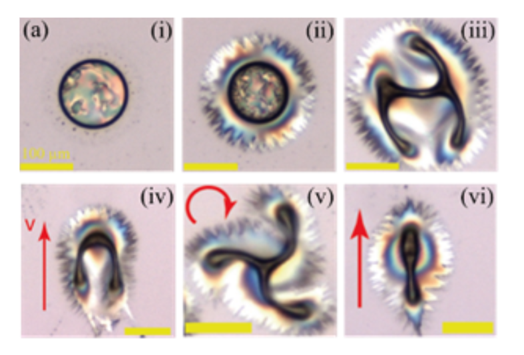Hungarian Researchers Discover New State of Matter: A Substance That Behaves as Both a Liquid and an Active Particle System
Researchers at the HUN-REN Wigner Research Centre for Physics have discovered a new state of matter, in which liquid droplets behave as actively moving, interacting particles under the influence of an electric field. Their findings could open new avenues in precision technology.
Researchers Péter Salamon and Marcell Tibor Máthé from the HUN-REN Wigner Research Centre for Physics have been studying a recently discovered special type of liquid known as ferroelectric nematic liquid crystals. They observed that the surface of ferroelectric nematic liquid droplets becomes unstable in an electric field, leading to the formation of fractal-like liquid extensions.
During the research, scientists observed that when a higher voltage was applied to the liquid droplets, their behavior became even more extreme: they lost their droplet shape and formed complex, maze-like structures. The researchers also found that when an alternating voltage was applied within a specific frequency range, the droplets began to move while changing shape. During movement, the droplets repelled each other and collided like particles, resembling active objects such as swarming insects, microbes, or microrobots. The researchers were also able to control the motion of the droplets using voltage, suggesting potential applications in new types of microfluidic devices. This discovery could have practical benefits in fields such as medical diagnostics, chemical analysis, and biotechnology.
The researchers also observed that this movement was accompanied by sound emission. The surprising phenomenon was explained through spectral analysis of the sound, which indicated that the droplets undergo mechanical vibrations when exposed to alternating voltage. The characteristic frequencies of these vibrations corresponded to the driving signal’s frequency and its second harmonic. The researchers published their findings in the prestigious journal Nature Communications.

Stationary (i-iii) and moving (iv-vi) ferroelectric nematic droplets in an electric field
Researchers also studied ferroelectric nematic liquid crystals in collaboration with Professor Antal Jákli from Kent State University (USA). Through this partnership, they were the first in the world to demonstrate the phenomenon of inverse piezoelectricity in three-dimensional liquids. The essence of this effect is that when voltage is applied to a ferroelectric nematic liquid, the material exhibits mechanical displacement proportional to the applied voltage. The phenomenon also works in reverse: mechanical deformation generates electrical charges on the surface of the material. In the kHz frequency range, the piezoelectric coupling constant of the studied material exceeds 1 nC/N, meaning that a force of one newton generates at least one nanocoulomb of charge. This value is comparable to that of the strongest piezoelectric solid materials, highlighting the exceptional piezoelectric properties of the studied liquid, despite not being in a solid state.
Understanding the electromechanical response of ferroelectric nematic liquid crystals enables the harvesting of mechanical energy and paves the way for the development of liquid actuators, micro-positioners, and electrically tunable optical lenses. The researchers published their findings in the prestigious journal Advanced Functional Materials.

